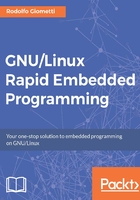
Chapter 6. General Purposes Input Output signals – GPIO
From this chapter, we're going to look more deeply at all the computer peripherals that we can use on our embedded machines, and since the most important and used peripherals are GPIO lines, let's start from them.
The GPIO signals are used for tons of different usages; in fact, even in previous chapters, in order to introduce the basic concepts of embedded computer programming, we could not avoid using them! However, earlier we just used them superficially; now we're going to show their usage in more detail.
First of all, we'll introduce the GPIO lines with a short description, and then we'll see where they are physically located in our embedded machines. Then, we're going to see in detail how we can get access to these lines in a very simple (but efficient) manner and then in a smarter (but a bit more complex) way.
The last step will cover a rapid introduction of the GPIOs management inside the kernel, so we'll look at how we can request and manage these peripherals as simple GPIOs or as a more specific manner as LED devices. In the first part, we'll take a look at GPIOs-related IRQs management, while regarding the LED devices, we'll take a look at the concept of trigger in more detail.